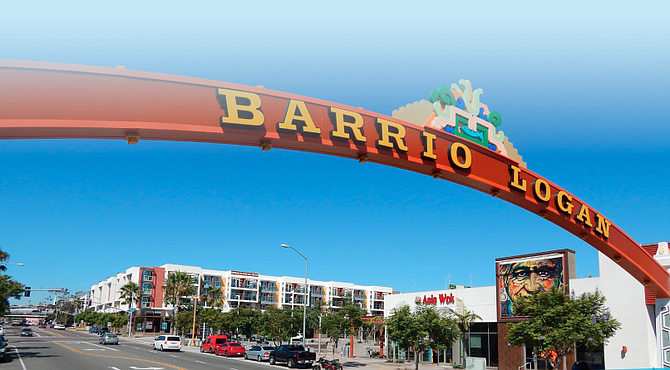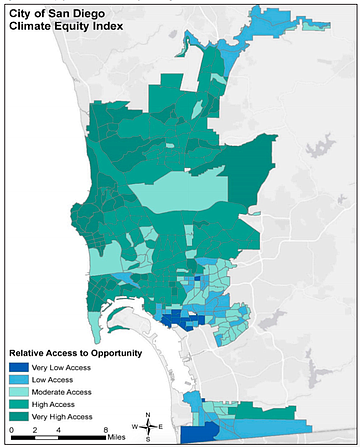 Facebook
Facebook
 X
X
 Instagram
Instagram
 TikTok
TikTok
 Youtube
Youtube

San Diego may have reduced greenhouse gases by 24 percent over the past decade, but bad air and high disease rates plague certain zip codes, as a new report makes clear.
For the first time, equity is being incorporated into the city's Climate Action Plan, and an analysis of 297 census tracts reveals several where help is needed most.
"To be blunt, it clearly shows our city does not allocate equal resources to communities where people of color live," said councilmember Vivian Moreno, whose district includes seven of the most forgotten census tracts.
The inclusion of equity, not typical of most climate plans, was an early goal of San Diego's Climate Action Plan, calling for the benefits of reducing emissions "to be shared equally, fairly and with lack of prejudice among all persons citywide.”
But when will the hardest hit areas begin to see the benefits?

Last week, the environmental committee discussed the 2019 Climate Equity Index, which compares opportunities and climate impacts throughout the city.
The equity working group and its partners used tools like CalEviroScreen to pinpoint communities affected by multiple sources of pollution.
There was good news: 152 census tracts have high to very high access to opportunity, with more public transit stops and sidewalks to get around, or they spend less income on housing and energy costs. In the middle, 125 have very low to moderate access.
But 13 tracts have very low access, and these – stuck with the worst commuting prospects, fewest grocery stores, and dirtiest air – include Barrio Logan, Lincoln Park, Nestor, the Tijuana River Valley, Logan Heights, and others in southeast San Diego.
"The sidewalks don't get fixed. We have streets that have gone unimproved for decades. There are city parks that should have been built decades ago that remain vacant," Moreno said.
The recommendation was to seek grant funding to support community engagement and invest in areas with very low to moderate access to opportunity. Another was to work climate equity into city programs, though no timeline has been set.
"It's definitely a step forward," said Carolina Martinez, policy director at Environmental Health Coalition, which criticized the city's 2015 Climate Action Plan, finding it short on environmental justice.
But people have already waited for ages, as asthma rates from the state Centers for Disease Control and Prevention show. Martinez asked that the city "identify immediate improvements to the top two communities so we don't wait until this index is fully adopted" by the climate plan.
And why wasn't air quality analyzed? "We're concerned that the index does not include air quality analysis."
It wasn't possible to do a citywide assessment due to the lack of air monitors, said Roberto Carlos Torres, social equity specialist. But "we did use kind of circumstantial indicators" of air quality.
Since they were unable to analyze air pollution and particulate matter, they looked at asthma rates, traffic congestion, cancer rates, and nearby facilities that release toxic chemicals.
In the future, there may be a technological solution that allows for more localized air quality information, but it's not practical now, said Ashley Rosia-Tremonti, Climate Action Plan program manager.
"A comprehensive air monitoring network for each census tract would likely be extraordinarily expensive."


San Diego may have reduced greenhouse gases by 24 percent over the past decade, but bad air and high disease rates plague certain zip codes, as a new report makes clear.
For the first time, equity is being incorporated into the city's Climate Action Plan, and an analysis of 297 census tracts reveals several where help is needed most.
"To be blunt, it clearly shows our city does not allocate equal resources to communities where people of color live," said councilmember Vivian Moreno, whose district includes seven of the most forgotten census tracts.
The inclusion of equity, not typical of most climate plans, was an early goal of San Diego's Climate Action Plan, calling for the benefits of reducing emissions "to be shared equally, fairly and with lack of prejudice among all persons citywide.”
But when will the hardest hit areas begin to see the benefits?

Last week, the environmental committee discussed the 2019 Climate Equity Index, which compares opportunities and climate impacts throughout the city.
The equity working group and its partners used tools like CalEviroScreen to pinpoint communities affected by multiple sources of pollution.
There was good news: 152 census tracts have high to very high access to opportunity, with more public transit stops and sidewalks to get around, or they spend less income on housing and energy costs. In the middle, 125 have very low to moderate access.
But 13 tracts have very low access, and these – stuck with the worst commuting prospects, fewest grocery stores, and dirtiest air – include Barrio Logan, Lincoln Park, Nestor, the Tijuana River Valley, Logan Heights, and others in southeast San Diego.
"The sidewalks don't get fixed. We have streets that have gone unimproved for decades. There are city parks that should have been built decades ago that remain vacant," Moreno said.
The recommendation was to seek grant funding to support community engagement and invest in areas with very low to moderate access to opportunity. Another was to work climate equity into city programs, though no timeline has been set.
"It's definitely a step forward," said Carolina Martinez, policy director at Environmental Health Coalition, which criticized the city's 2015 Climate Action Plan, finding it short on environmental justice.
But people have already waited for ages, as asthma rates from the state Centers for Disease Control and Prevention show. Martinez asked that the city "identify immediate improvements to the top two communities so we don't wait until this index is fully adopted" by the climate plan.
And why wasn't air quality analyzed? "We're concerned that the index does not include air quality analysis."
It wasn't possible to do a citywide assessment due to the lack of air monitors, said Roberto Carlos Torres, social equity specialist. But "we did use kind of circumstantial indicators" of air quality.
Since they were unable to analyze air pollution and particulate matter, they looked at asthma rates, traffic congestion, cancer rates, and nearby facilities that release toxic chemicals.
In the future, there may be a technological solution that allows for more localized air quality information, but it's not practical now, said Ashley Rosia-Tremonti, Climate Action Plan program manager.
"A comprehensive air monitoring network for each census tract would likely be extraordinarily expensive."
Comments